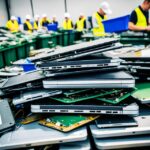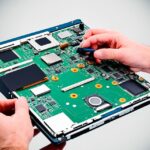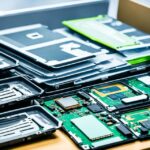Understanding the Lifecycle of a Recycled Laptop
In today’s digital age, laptops have become an essential tool for work, communication, and entertainment. However, the rapid advancement of technology means that many laptops quickly become outdated and are eventually discarded. But what happens to these laptops after they are no longer useful?
The lifecycle of a recycled laptop is a fascinating process that involves careful dismantling, sorting, and recycling of its components. It begins with the manufacturing process, where various materials are used to create the circuit board, chassis, battery, and other parts of the laptop. Once a laptop reaches the end of its functional life, it is discarded by the consumer. This is where the role of an electronic recycler comes into play.
In the following sections, we will delve deeper into the stages of the laptop’s lifecycle, the importance of recycling electronics, and the environmental impact of this process. Join us on this journey to discover the sustainable impact of recycling laptops and how it contributes to a more eco-friendly future.
The Role of E-Waste Recycling
An electronic recycler plays a crucial role in every step of the laptop’s lifecycle. Even before the manufacturing process begins, e-waste recycling is already underway. Manufacturers send engineering samples, dies, and specialized test equipment to electronic recyclers. During the manufacturing stage, the recycler handles products that don’t meet quality control standards, as well as excess parts and board trimmings. In the distribution process, the recycler deals with damaged units, in-store demos, product returns, and overstock.
However, the most impactful step is when consumers decide to recycle their laptops instead of throwing them away. By choosing to recycle, individuals contribute to the reduction of e-waste in landfills and the conservation of valuable resources. Electronic recyclers ensure that laptops are properly disassembled, and their components are either refurbished for reuse or transformed into clean raw materials for the production of new products. This environmentally responsible approach helps to minimize the negative impact of e-waste on the planet and promotes a more sustainable future.
“We aim to make e-waste recycling a seamless process for both manufacturers and consumers. Through our expertise and specialized facilities, we ensure that every electronic device is handled responsibly, maximizing its potential for reuse or recycling.”
The Key Responsibilities of an Electronic Recycler
| Stage | Responsibilities |
|---|---|
| Manufacturing | Handling of products that don’t meet quality control standards, excess parts, and board trimmings |
| Distribution | Dealing with damaged units, in-store demos, product returns, and overstock |
| Consumer Recycling | Ensuring proper disassembly, refurbishment for reuse, or transformation into clean raw materials |
The Collection and Sorting Process
The first step in the laptop recycling process is the collection of laptops. Electronic recyclers play a crucial role in coordinating the packing and shipping of these items to minimize their carbon footprint. Once the laptops arrive at the recycling facility, they are carefully tagged and inventoried to ensure proper tracking.
At the facility, the laptops go through a thorough sorting process. This involves categorizing the items into different streams based on their material composition. The goal is to ensure that downstream recyclers can handle each type of material appropriately, maximizing the efficiency of the recycling process.
Laptops receive special attention during the sorting process. The electronic recyclers take extra care to remove and sanitize all data and storage devices to protect the privacy of the original owners. This ensures that all personal information is safely erased before further processing.
Items that are relatively new and free of heavy cosmetic or functional damage are identified for refurbishment or repair. These laptops have the potential to be reused, supporting the circular economy. Refurbishment involves restoring the functionality and appearance of the laptops, making them suitable for resale or donation.
However, laptops that are beyond their usable life or physically damaged are considered scrap. These laptops are sent for further processing to extract valuable materials and reduce waste.
Key Points:
- Electronic recyclers coordinate the collection and shipping of laptops to reduce their carbon footprint.
- Laptops are tagged, inventoried, and sorted into different material streams at the recycling facility.
- Data and storage devices are removed and sanitized during the sorting process to protect privacy.
- Relatively new and undamaged laptops are refurbished or repaired for reuse.
- Laptops beyond their usable life or physically damaged are considered scrap and undergo further processing.
Dismantling and Processing the Scrap Material
Once scrap laptops that are not suitable for reuse are received by the electronic recycler, they undergo a meticulous dismantling process to separate them into basic components. This de-manufacturing process is carried out by skilled technicians who carefully disassemble the laptops by hand, ensuring that every part is accounted for.
During this dismantling process, the electronic recycler sorts the components into different streams based on their material composition. Metals, such as steel, aluminum, and copper, are separated from boards and plastics, allowing for efficient processing and recycling of each material type.
However, it’s important to note that not all components of a scrap laptop are immediately recyclable in their present form. Some items, such as damaged or outdated circuit boards, may undergo additional processing methods like shredding or shearing to transform them into raw commodities that can be used in the production of new electronic devices.
Once the necessary processing steps have been completed, the electronic recycler collects the processed raw materials and ships them to partner facilities that specialize in the recycling and refining of each specific commodity. For example, plastics are sent to dedicated plastics recycling facilities, while metal yards handle the recycling of metals like steel, aluminum, and copper.
The Scrap Material Processing Process:
- Dismantling the scrap laptops by hand to separate them into basic components.
- Sorting the components into different streams based on their material composition.
- Processing methods such as shredding or shearing to transform certain components into raw commodities.
- Collecting and shipping the processed raw materials to partner facilities specializing in the recycling of each specific commodity.
The efficient dismantling and processing of scrap laptops by electronic recyclers ensure that valuable materials are diverted from landfills and given a new life, reducing the demand for virgin raw materials and contributing to a more sustainable future.
Refinement and Reuse of Recycled Materials
The partner facilities play a crucial role in refining and repurposing recycled materials, transforming them into valuable resources for future products. Specialized smelters are responsible for extracting precious metals from circuit boards, ensuring that no valuable resources go to waste.
By refining recycled materials, specialty recyclers aim to create clean raw materials that can be reused in various industries. For instance, the plastic casing of a laptop can be repurposed as the bezel of a new smartphone, showcasing the versatility of recycled materials. Additionally, metals extracted from recycled laptops can be utilized in the production of electric vehicles, contributing to the development of sustainable transportation.
This process of refinement and reuse helps significantly reduce dependence on finite raw materials, promoting a more sustainable future. By utilizing recycled materials, companies can decrease their environmental impact and contribute to a circular economy, where resources are efficiently recycled and repurposed rather than discarded.
Benefits of Refinement and Reuse of Recycled Materials
- Conservation of natural resources: Repurposing recycled materials reduces the need for extracting virgin raw materials from the earth, preserving valuable natural resources.
- Reduction of carbon emissions: By utilizing recycled materials, companies can lower their carbon footprint associated with mining and manufacturing processes.
- Energy conservation: Refining and reusing recycled materials consumes less energy compared to producing new materials from scratch.
- Promotion of a circular economy: Emphasizing the reuse of materials creates a sustainable cycle of resource utilization and reduces reliance on single-use products.
Overall, through refinement and reuse of recycled materials, we can actively contribute to a more sustainable and environmentally conscious future.
“By repurposing recycled materials, we can minimize waste, conserve resources, and drive the shift towards a circular economy.”
| Recycled Material | Potential Reuse |
|---|---|
| Plastic casing | Bezel of a new smartphone |
| Precious metals (from circuit boards) | Used in the production of electric vehicles |
| Metals (steel, aluminum, copper) | Component in the manufacturing of various products |
The Environmental Impact of the Laptop Lifecycle
The lifecycle of a laptop has a significant environmental impact. The production process, including mining, manufacturing, packaging, and transportation, requires a large amount of energy and resources. Only 34% of a computer’s life cycle energy consumption occurs during its use phase, while the rest is needed for the various stages of production. By recycling laptops and other electronics, we can reduce the demand for virgin raw materials, decrease pollution and carbon emissions, and conserve energy and water consumption. Recycling also keeps useful materials out of landfills and promotes a more circular economy.
The production of laptops involves resource-intensive processes that contribute to environmental degradation. The extraction of raw materials, such as metals and minerals, requires extensive mining operations that can lead to habitat destruction, soil erosion, and water pollution. Additionally, manufacturing and packaging components of laptops consume energy and generate greenhouse gas emissions. The transportation of laptops across the supply chain further adds to their environmental footprint.
However, recycling laptops presents an opportunity to mitigate these environmental impacts. By recycling a laptop, not only are valuable materials recovered and reused, but the need for extracting new raw materials is reduced. This helps to conserve natural resources, prevent habitat destruction, and minimize the energy and water consumption associated with mining and manufacturing processes.
Furthermore, laptop recycling has a positive effect on reducing pollution and carbon emissions. If laptops are disposed of in landfills, they can release harmful chemicals into the surrounding environment and contribute to air and water pollution. By properly recycling laptops, we can prevent these toxins from entering ecosystems and protect human and environmental health.
The Benefits of Laptop Recycling
- Conservation of Resources: Recycling laptops reduces the demand for raw materials, preserving valuable resources like metal ores and reducing the need for energy-intensive extraction processes.
- Reduction in Carbon Emissions: The recycling process emits fewer greenhouse gases compared to mining and manufacturing new laptops, helping to mitigate climate change.
- Prevention of Landfill Waste: Recycling laptops diverts electronic waste from landfills, where hazardous materials can leach into the environment and contaminate soil and water sources.
- Circular Economy: By recycling laptops and recovering materials, we can create a circular economy where resources are continuously reused, reducing the reliance on finite raw materials.
“Recycling laptops and other electronics is a crucial step towards achieving a more sustainable future.”
Overall, the environmental impact of the laptop lifecycle highlights the importance of responsible disposal and recycling. By extending the lifespan of laptops through refurbishment and recycling their components, we can minimize waste, conserve resources, and reduce pollution. It is essential for individuals, businesses, and governments to prioritize laptop recycling as part of a comprehensive approach to environmental sustainability.
The Importance of Recycling Electronics
Recycling electronics is crucial to minimize their impact on the environment. Computers and electronic equipment are made from various types of plastic, metal, glass, and precious metals, all of which can be recycled and reused. By recycling electronic waste, we can ensure that these materials are properly separated and processed, allowing them to be used in the production of new products.
When we use recycled materials in the manufacturing process, we reduce the need for extracting raw materials from the earth. This helps conserve natural resources and reduces the carbon footprint associated with mining and manufacturing processes. Additionally, recycling electronics contributes to the reduction of pollution and waste sent to landfills, promoting a more sustainable and circular economy.
“Recycling turns things into other things, which is like magic.” – Anonymous
By responsibly recycling electronics, we can make a positive environmental impact. Instead of allowing these items to sit in landfill sites for years, we can give them a new life by recycling their components and turning them into valuable resources.
The Benefits of Recycling Electronics:
- Conserves natural resources
- Reduces energy and water consumption
- Minimizes pollution and carbon emissions
- Promotes a circular economy
Recycling electronics is an essential part of creating a sustainable future. By taking the necessary steps to properly recycle our electronic devices, we can play our part in protecting the environment for generations to come.
Conclusion
The lifecycle of a recycled laptop encompasses various stages, starting from manufacturing to refurbishing, dismantling, and material processing. Electronic recyclers, such as [Brand Name], play a vital role in ensuring laptops are properly recycled, with components either reused or transformed into clean raw materials. Recycling laptops and other electronics has significant benefits, including reducing our reliance on finite raw materials, conserving resources, minimizing pollution and carbon emissions, and promoting a more sustainable and circular economy.
By prioritizing the recycling of electronics, individuals and businesses can make a positive and sustainable impact on the environment. Recycling laptops helps to minimize the extraction of raw materials, conserving natural resources and reducing the carbon footprint associated with mining and manufacturing processes. Furthermore, it diverts valuable materials from ending up in landfills, contributing to a more circular approach to resource management.
In the quest for a greener future, the proper recycling of laptops is of utmost importance. It not only extends the lifecycle of these devices but also enables the recovery and reuse of valuable materials. Embracing recycling as a collective responsibility empowers us to mitigate the environmental impact of discarded electronics. Let’s all make a conscious effort to recycle laptops and other electronics, safeguarding our planet for future generations.
FAQ
What is the lifecycle of a recycled laptop?
The lifecycle of a recycled laptop involves various stages, from manufacturing to refurbishing, dismantling, and processing of materials. Electronic recyclers play a vital role in ensuring that laptops are properly recycled and their components are reused or turned into clean raw materials.
What is the role of e-waste recycling in the lifecycle of a laptop?
E-waste recycling plays a crucial role in every step of the laptop’s lifecycle. Electronic recyclers handle products that don’t meet quality control standards during the manufacturing stage, as well as excess parts and board trimmings. In the distribution process, they deal with damaged units, in-store demos, product returns, and overstock. Most importantly, electronic recyclers help consumers recycle their laptops instead of throwing them away.
How does the collection and sorting process work in laptop recycling?
Electronic recyclers coordinate the packing and shipping of laptops to reduce their carbon footprint. Once the equipment arrives at the recycling facility, it is tagged and inventoried. The items are then sorted into different categorized streams to ensure appropriate handling of each type of material. Laptops are given special attention to remove and sanitize all data and storage devices. Items suitable for reuse are refurbished or repaired, while those beyond their usable life and physically damaged are considered scrap.
What happens to the scrap material during laptop recycling?
Scrap laptops that are not suitable for reuse are dismantled into basic components. The electronic recycler de-manufactures the laptop by hand and sorts it into separated metals, boards, and plastics. Other items from the load may undergo shredding, shearing, or other processing methods to turn them into raw commodities. Processed raw materials are then shipped to partner facilities specializing in each specific commodity, such as plastics and metals.
How are recycled materials refined and reused?
Partner facilities refine recycled materials by turning them into ingots for use in future products. Specialized smelters are responsible for extracting precious metals from circuit boards. The goal is to create clean raw materials that can be sold back to start the life cycle of new products. For example, plastic casings can become the bezel of a new smartphone, and metals can be used in the production of electric vehicles.
What is the environmental impact of the laptop lifecycle?
The lifecycle of a laptop has a significant environmental impact due to the energy and resources required during the production process. Only a small portion of a computer’s life cycle energy consumption occurs during its use phase, while the rest is needed for various production stages. Recycling laptops and other electronics helps reduce the demand for virgin raw materials, decrease pollution and carbon emissions, conserve energy and water consumption, and promote a more sustainable future.
Why is recycling electronics important?
Recycling electronics is crucial to minimize their impact on the environment. Computers and electronic equipment are made from various types of plastic, metal, glass, and precious metals, all of which can be recycled and reused. Recycling electronic waste ensures that these materials are separated and properly processed, allowing them to be used in the production of new products. This reduces the need for extracting raw materials from the earth, conserves natural resources, and reduces the carbon footprint associated with mining and manufacturing processes.
What is the overall impact of recycling laptops on sustainability?
Recycling laptops and other electronics has a sustainable impact by reducing dependence on finite raw materials, conserving resources, reducing pollution and carbon emissions, and promoting a more circular economy. It is important for individuals and businesses alike to prioritize recycling electronics to minimize their environmental impact.















